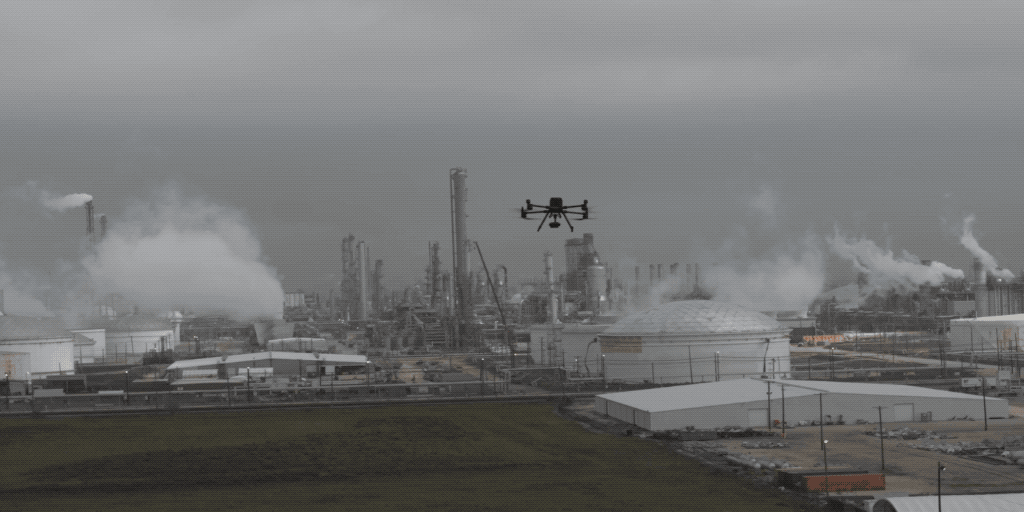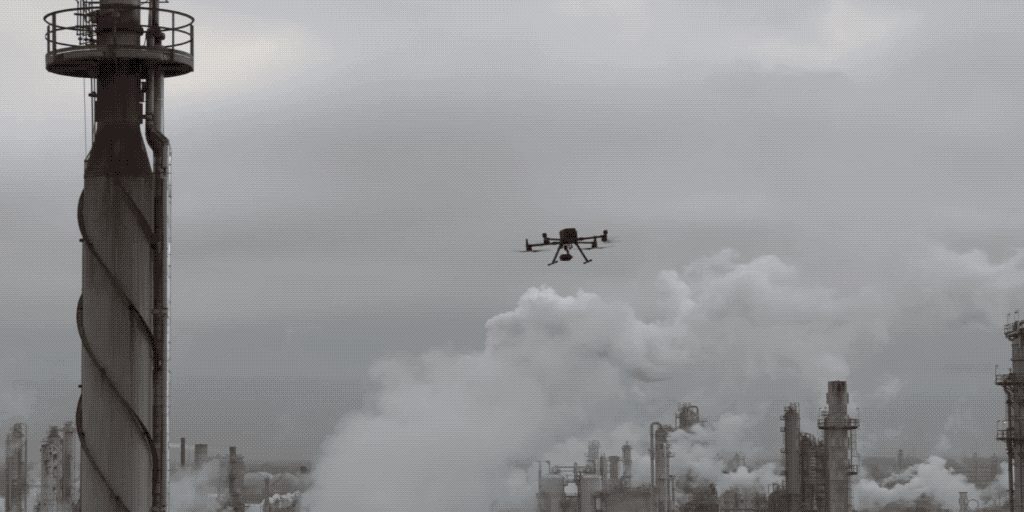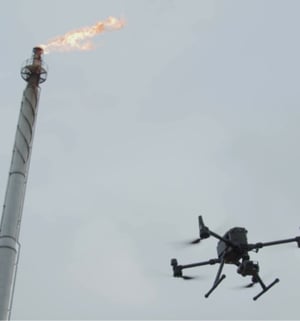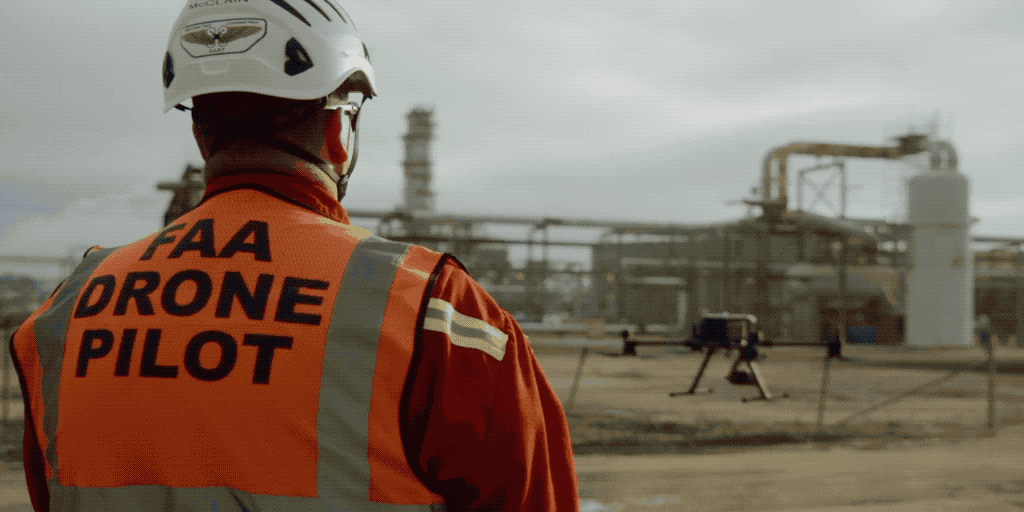Shell is a multinational Oil and Gas giant headquartered in the Netherlands with operations in more than 70 countries. By 2020 revenue, it’s the fifth-largest company in the world.
Shell started using drone technology in 2012. Flying robots have since become established inspection tools across the company’s global asset portfolio, offering a cost-effective and safe way to gather data - particularly from the hard-to-reach and hazardous environments associated with Oil and Gas.
As the benefits and applications of drone technology have grown in scope and credibility, Shell’s drone program has followed suit. It’s common in the industry for inspection-related tasks at assets to be carried out by third parties. On the whole, Shell’s drone missions follow that pattern. But at certain locations, including Shell’s Deer Park Manufacturing Complex, the company manages its own fleet.
The person in charge of overseeing Shell’s adoption of drone technology is Robotics Theme Lead Adam Serblowski.

Developing a drone program
Shell has developed and deployed robotics solutions throughout its businesses. With drones, the focus is on monitoring. Solutions from DJI provide insights from above that help engineering teams observe and maintain the condition of assets and facilities.
Serblowski explains that Shell’s adoption of drones started small with a focus on flare tip inspections in 2012.
“And it took a long time to get there,” he says. “There was a lot of engagement with assets and concerns about the drone getting caught in the wind or crashing.
But once the first inspection had been done, it was one of those no-brainer things to replicate. It was fairly low risk and you’re getting the same or better imagery compared to having a person up there.”

The safety and operational improvements became obvious and the program developed from there.
In the first few years, a lot of Shell’s drone inspections were simple: gathering images that would have otherwise required staff to work at height, increasing their safety risk.
“We then started to see the technology grow in our geomatics space,” says Serblowski. Shell’s drone program has developed with the addition of surveys and ortho maps.
Operations at Deer Park, Texas, have become the benchmark. Since 2016, the drone team there has pioneered the development of standard operating procedures for the company’s sites worldwide. Alongside Chief Drone Pilot John McClain, Serblowski has introduced new hardware and applications, allowing drones to support a combination of scheduled inspections and incident response.
What’s new is the idea of Shell actually owning and operating the drones.
“The vast majority of drone missions done for Shell are still done by third parties. But at some of our fixed assets, as the work scope has increased, it’s made more sense to bring these drones in house,” says Serblowski.
This transition is not something that Shell is specifically mandating. Different countries and different business units have different drivers, and so bringing things in-house may make sense in one area or discipline and not in another.
“But the concepts are exactly the same, whether it’s a third party operating or ourselves operating. We know there’s a lot of scope for drones at many individual assets. And embedding them into day to day operations represents a way to improve performance in a variety of ways.”
Adopting drone technology in the risk-averse world of oil and gas
Over the years, drone technology has developed a remarkable safety record. In part this is due to advances in hardware and software; ADS-B receivers and sophisticated sense and avoid technology now come as standard on DJI enterprise platforms.
But this is aviation and there remains a degree of risk. “In terms of challenges to adoption, the biggest comes down to conservatism. As an industry, we are risk-averse for good reason. The consequences of something going wrong have the potential to be very severe,” says Serblowski.
That conservatism feeds into how things are done. Processes are long-established and it takes time and effort for a new technology to disrupt them.

“Anytime we bring in a new piece of technology there’s a certain amount of risk involved with that. Convincing people to adopt that technology and take that risk the first time takes a lot of work. You really need to do that leg work to show people how safe it is.”
For Serblowski this highlights the importance of documenting every stage of how a new application works in practice.
“In the early days you don’t have those go-to support mechanisms in terms of standards and processes. Once you get that first deployment done, you can start to build that up, which makes it easier for the next person to take a look. They’ve got evidence and processes to support doing it safely.”
The second challenge Serblowski outlines is exclusive to organizations developing drone programs across borders.
“One of the unique challenges you’ve got to deal with when using drones versus other technology is that country by country you have different regulations. There are certain countries where it would be desirable to fly but it’s difficult to even develop simple use cases because of local regulations.”
Building a drone program with third parties
The world of Oil and Gas is driven by service industries. At Shell’s facilities, the vast majority of inspections and maintenance work is carried out by third party companies. It follows that working with trusted external partners is one way to bring the benefits of drones onto sites and speed up the adoption process.
“That’s the model, so bringing drone operations in-house is actually the outlier. It’s not something we’ve typically done. But because it’s a new piece of technology and it crosses so many different boundaries, the opportunity is there to bring it in-house. It makes sense in some cases,” says Serblowski.
Building internal drone teams isn’t something Shell is mandating across the board, as there are still potential benefits in having third parties carry out tasks.
 But Serblowski points out that no matter the service provider, “the underlying equipment, tools and concept will be exactly the same.”
But Serblowski points out that no matter the service provider, “the underlying equipment, tools and concept will be exactly the same.”
Shell pilots and those working on behalf of the company work according to established processes in place to ensure operations and the data coming out remain consistent.
On top of that, an organization as large as Shell can usually count on internal expertise that can be leveraged during the drone adoption process.
Serblowski explains that business units such as Shell Aircraft are able to put processes in place and provide assurance that the third parties being brought in are of the highest caliber.
“We have a document internally, the shell group requirements for aircraft operation, and that covers all of our drone vendors. Before anyone puts a drone in the air, we’ve got a very high level of confidence that they are a competent vendor.”
Beyond flight methodologies, those standards extend to the data captured.
“They know exactly what you’re looking at and are able to deliver the imagery you need. What we’re starting to see is the development of specific data standards, so we can ensure we’re getting greater consistency in what we capture.”
The importance of a drone program manager
To gain all of the advantages that flying robots can bring to complex working environments, organizations need to have someone responsible for taking the reins and driving a program forward.
The role of drone program manager is part communication, part knowledge management.
“People want to have someone they can talk to,” says Serblowski. It’s one thing to be able to send across documents and maintain portals that get people needed information. But being able to talk to them and their specific circumstance, creating documents and capturing the lessons learned from different deployments and driving those replications… that’s what is really important.”

He argues that communication is the most important skill for a drone program manager, alongside an understanding of what the business drivers are at a given site.
“You don’t necessarily need to understand their processes,” he says. “I can’t tell you the individual differences which make each refinery unique. But what I can do is understand their pain points and what’s driving them on a day to day basis. By understanding their limitations, you’re able to better explain how a solution can work for them and help.”
How a new solution is presented can also make an impact.
“If you come in selling the solution in the wrong way, you can lose a lot of people before they have a chance to understand what the benefits are.”
Drones as part of the bigger picture
Drones make up one part of Shell’s wider digital strategy, which is focused on supporting smarter and faster decision making.
“We see drones as generic data collection tools that drive information gathering without increasing operational exposure. We can keep people out of harm’s way and don’t have to put them in potentially hazardous situations to get the data we need,” says Serblowski.
In the coming months and years, the expectation is that drone technology will become a daily feature at more of Shell’s operating assets - and not just for highly specialized tasks.
“Over the last decade drones have demonstrated a lot of value as ad-hoc tools. So now we’re looking at how we can leverage them as a day to day tool rather than a specialized one.”
Once the use of drones is normalized, the technology will be embedded into day to day task lists.
“That’s where we’ll see the change,” says Serblowski.
“We’ll see more adoption in day to day use. We’ll see drones in the air more regularly at these facilities supporting a wider range of activities than we do today. And by aggregating a lot of these activities, which on their own wouldn’t support a drone inspection, you end up with a large justification for continuing to expand these programs.”



.png?width=300&name=FH2%20update%20(1).png)
-1.png?width=300&name=HS%20-%20Featured%20Images%20(3)-1.png)
